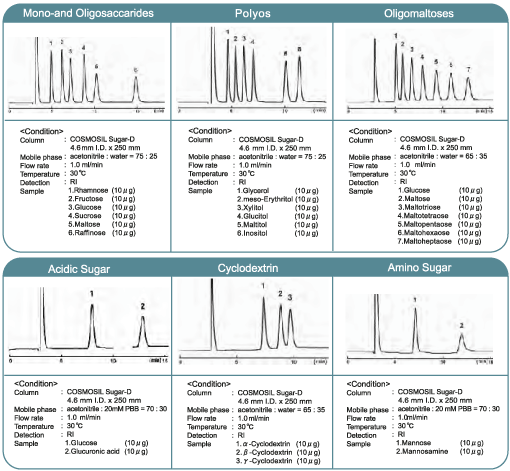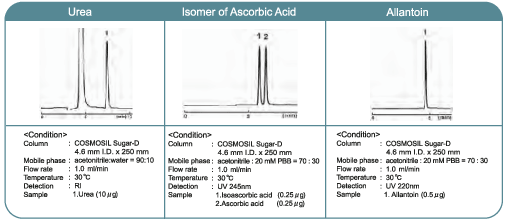Conventionally Aminopropyl bounded stationary phases are used for liquid chromatographic analysis of mono- and oligosaccharides. General shortcomings of the conventional Aminopropyl bounded phases are tailing and adsorption of certain saccharides and general low durability (short active life) of these columns. These problems are addressed and solved by the novel COSMOSIL ® Sugar-D, resulting in better (sharper) separation and much improved durability.
Durability
The decrease of retention time was compared between COSMOSIL ® Sugar-D and conventional Aminopropyl bounded stationary phase under severe condition of 100% water as eluent between tests. The capacity factor did not decrease in case of COSMOSIL ® Sugar-D.

| Eluent condition | |
| Eluent Flow rate Temperature | : water : 1.0 ml/min : RT |
Test condition | |
| Column size Mobile phase Flow rate Temperature Detection Sample | : 4.6 mmI.D.×250 mm : acetonitrile:water=70:30 : 1.0 ml/min : 30°C : RI : Maltose |
Absortion characteristic
Certain types of saccharides such as Arabinose or Galactose are partially or temporarily absorbed in conventional Aminopropyl stationary phases causing disappearance of sample or tailing. These problematic saccharides elute sharply and in proportion of the injection volume from the superior COSMOSIL ® Sugar-D.
Chromatogram

Analitical curve



| Condition | |
| Column size : 4.6 mmI.D.×250 mm Mobile phase : acetonitrile:water=70 : 30 Flow rate : 1.0 ml/min Temperature : 30°C Detection : RI | Sample 1.Arabinose 2.Galactose 3.Maltitol |
Comparison
Retention Time

Analysis

Analysis

